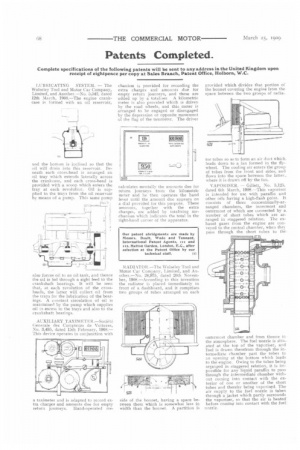Patents Completed.
Page 24

If you've noticed an error in this article please click here to report it so we can fix it.
Complete specifications of the following patents will be sent to any address in the United Kingdom upon receipt of eightpence per copy at Sales Branch, Patent Office, Holborn, W.C.
LUBRICATING SYSTEM. — The Wolseley Tool and Motor Car Company, Limited, and Another.—No. 5,542, dated 12th March, 1908.—The engine crankcase is formed with an oil reservoir, and the bottom is inclined so that the oil will drain into this reservoir. Beneath each cross-head is arianged an oil tray which extends laterally across the crankcase, and each cross-head is provided with a scoop which enters the tray at each revolution. Oil is supplied to the trays from the oil reservoir by means of a pump. This same pump also forces oil to an oil tank, and thence the oil is fed through a sight feed to the crankshaft bearings. It will he seen that, at each revolution of the crossheads, the latter will collect oil from the trays for the lubrication of the bearings. A constant circulation of oil is maintained by the pump which supplies oil in excess to the trays and also to the crankshaft bearings.
AUXILIARY TAXIMETER.—Societ0. Generale des Compteurs de Voitures, No. 3,493, dated 13th February, 1908.— This device operates in conjunction with a taximeter and is adapted to record extra charges and amounts due for empty return journeys. Hand-operated me chanism is provided for recording the extra charges and amounts due for empty return journeys, and these are added up by a totaliser. A kilometric meter is also provided which is driven by the road wheels, and this meter is arranged to be engaged or disengaged by the depression or opposite movement of the flag of the taximeter. The driver
calculates mentally the amounts due for return journeys from the kilometric meter and he then operates the hand lever until the amount due appears on a dial provided for this purpose. These amounts, together with the extra charges, are added by totalising mechanism which indicates the total in the right-hand corner of the apparatus.
RADIkTOR.—The Wolseley Tool and Motor Car Company, Limited, and Another.—No. 24,975, dated 20th November, 1908.—According to this invention the radiator is placed immediately in front of a dashboard, and it comprises two groups of tubes arranged on each side of the bonnet, having a space between them which is somewhat less in width than the bonnet. A partition is
provided which divides that portion of the bonnet covering the engine from the space between the two groups of radia tor tubes so as to form an air duct which. leads down to a fan formed in the flywheel. The cooling air enters the group of tubes from the front and sides, and flows into the space between the latter,. where it is drawn off by the fan.
VAPORISER. — Gillett, No. 5,123, dated 6th March, 1908.—This vaporiser is intended for use with paraffin and other oils having a high-flash point. It. consists of three concentrically-arranged chambers, the innermost and outermost of which are connected by a. number of short tubes which are arranged in staggered relation. The exhaust gases from the engine are conveyed to the central chamber, when the3 pass through the short tubes to the outermost chamber and from thence tc the atmosphere. The fuel nozzle is situ-. pted at the top of the vaporiser, and fuel is drawn therefrom through the intermediate chamber past the tubes to an opening at the bottom which leads to the engine. Owing to the tubes being arranged in staggered relation, it is impossible for any liquid paraffin to pass through the intermediate chamber without coining into contact with the exterior of one or another of the short tubes and thereby being vaporis,ed. The air supply to the fuel nozzle is taken through a jacket which partly surrounds the vaporiser, so that the air is heated. before coming into contact with the fuel nozzle.
























